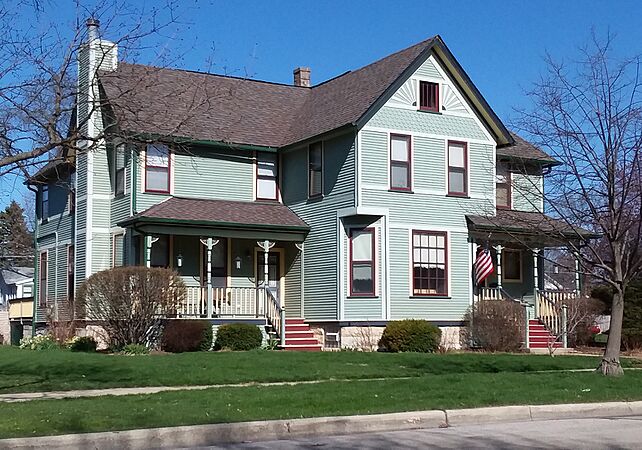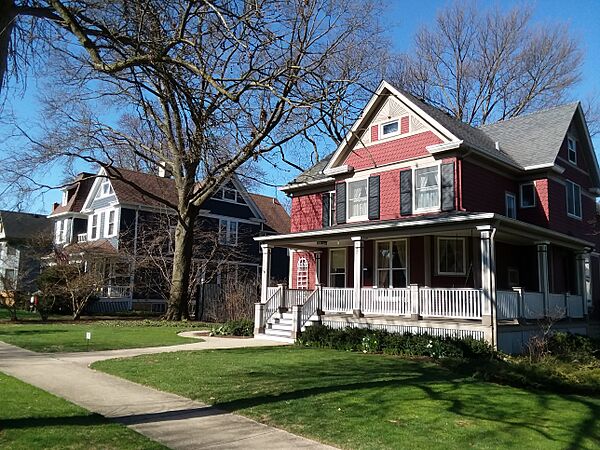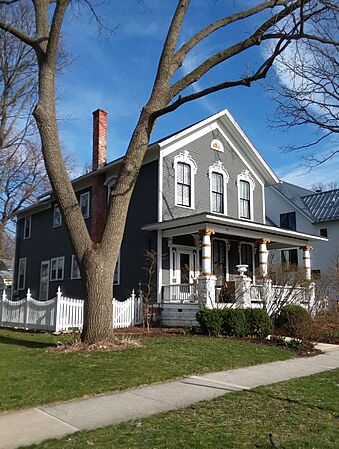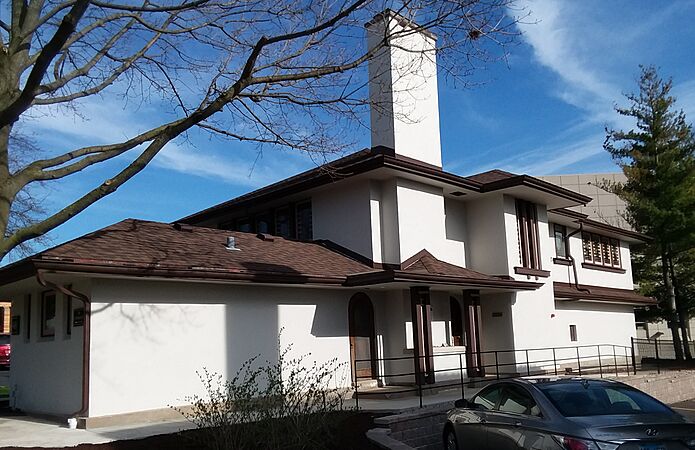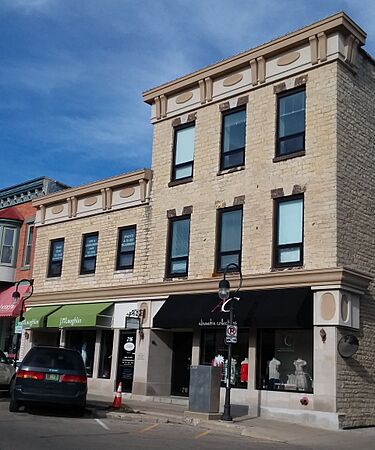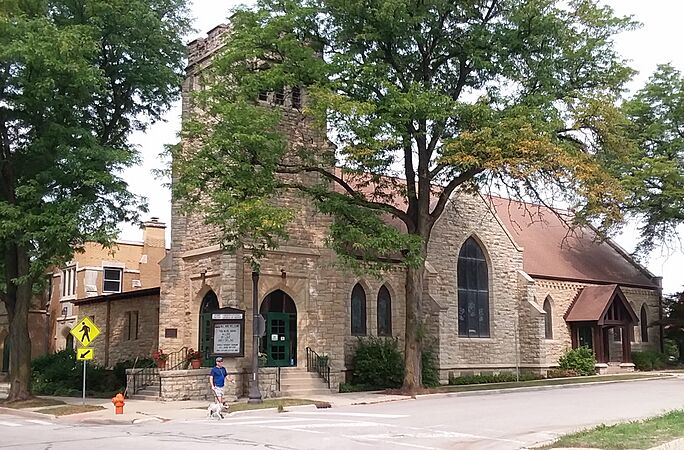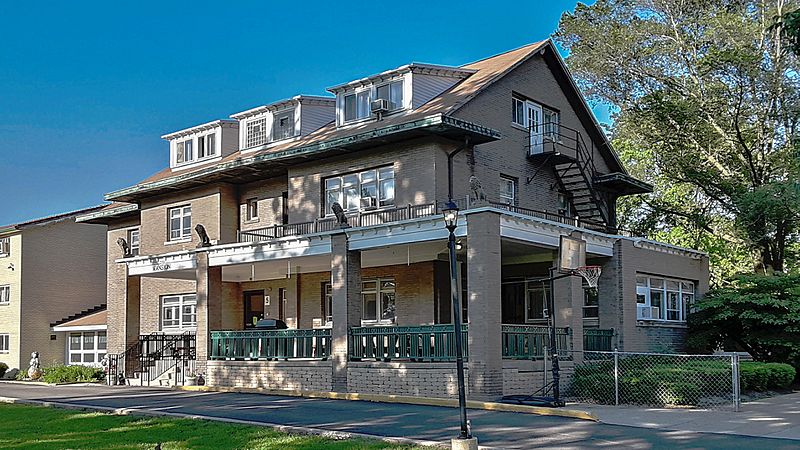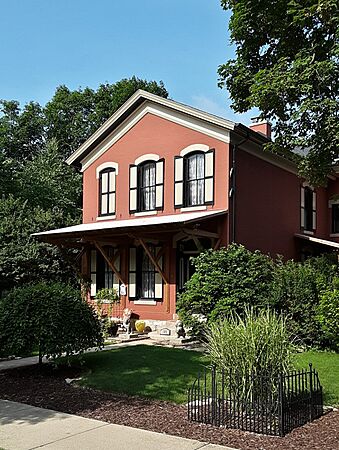Naperville Historic District facts for kids
Quick facts for kids |
|
|
Naperville Historic District
|
|
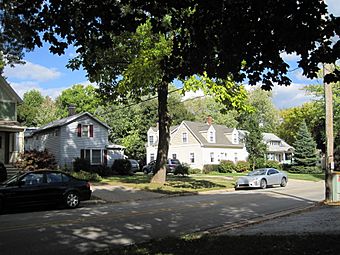
North Avenue in the Naperville Historic District
|
|
| Location | Roughly bounded by Juilian, Highland, Chicago, Jackson, Eagle, and 5th Sts. Naperville, DuPage County, Illinois, U.S. |
|---|---|
| Architectural style | Greek Revival, Italianate, Prairie School |
| NRHP reference No. | 77001516 |
| Added to NRHP | September 29, 1977 |
The Naperville Historic District is a special area in Naperville, Illinois. It includes 613 buildings, and 544 of them are important because they show the town's history. This district helps us see what Naperville looked like when it was first planned and in its early years.
Contents
Naperville's Early History
The first settlement in Naperville began in 1830. Stephen Scott started a farm along the DuPage River. Soon, other families moved to the area. They built a sawmill, a grist mill, a trading post, and a school.
One of the first settlers was Joseph Naper. In 1831, he claimed land and built a cabin. By 1832, about 180 people lived in the Naperville area.
Important Events in Naperville
In 1832, families briefly left the village. They went to Fort Dearborn during the Black Hawk War. Most people returned after the fighting ended. The first post office was built in 1833.
A major road, the Galena Road, opened in 1834. This road connected Chicago and Galena. It helped bring more business to Naperville.
From the 1850s to the early 1870s, Naperville had a disagreement with Wheaton. Both towns wanted to be the main city, or county seat, for DuPage County. Naperville even built a courthouse. However, a court decided that Wheaton would be the county seat. The courthouse was later taken down and turned into a park.
The First Congregational Church of Naperville was started in 1833. It is the oldest church in DuPage County.
Naperville's Economic Growth
Naperville became successful by using its local resources. Stone quarries dug up limestone. Breweries made alcohol. Three different plant nurseries also grew well.
Other important businesses included Naperville Agricultural, which made farming tools. Martin Mitchell's Naperville Title and Brick Works was also a key industry. By World War I, the biggest employer was Naperville Manufacturing Co. This company later became a top furniture exporter in the country.
Plainfield College moved to Naperville in 1870. It was later renamed North Central College. The Evangelical Theological Seminary started in 1873. It was closely connected to North Central College. These two schools merged in 1974.
Despite its economic and religious growth, Naperville grew slowly at first. In 1910, only 3,449 people lived there. The town's population grew a lot in the 1950s. This was because it became easier to travel. Naperville became a popular suburb of Chicago. Most of the older parts of town are still in good condition today.
Protecting Naperville's History
The Naperville City Council created the Naperville Historic District in 1986. This was done to protect the town's important historical buildings.
In 2019, North Central College planned to buy and tear down the P. E. Kroehler mansion. This building was owned by Little Friends. The college wanted to build new school buildings there. However, the college later decided not to buy the mansion. Little Friends still said they planned to ask to tear down the building.
Important Historic Buildings
Naperville has chosen twenty sites and buildings that are very important. They show the historical value of the district.
- Willard Scott, Jr. House (1887) – Willard Scott, Jr. was Stephen Scott's son. He ran Scott's General Store and the Naperville Hotel.
- Elmholm (built before 1917) – Designed by Harry Robinson. The owner, Rollo M. Givler, owned the local newspaper called Clarion.
- 205 North Wright – The seminary bought this building in 1908. It was moved in 1912 to be used as a dormitory.
- 122 South Brainard (1874) – Owned by the Hammerschmidt family, known for their quarrying business.
- North Central College (1870) – Designed by John M. Van Osdel. The south part was added in 1890.
- Nichols House (1917) – Designed by Harry Robinson.
- 227 East Jefferson (1866) – Designed by G. N. Gross. Later, it was the home of ecologist May Theilgaard Watts.
- Dieter House (1846) – Designed by Dr. David Hess. It was moved to its current spot in 1898.
- Wilson House (c. 1879)
- Kroehler Manufacturing Company (1905) – Changes were made in 1909 and 1913.
- Paw Paw Station (1833) – This was the first public building in the county (a post office). It has been changed a lot over time.
- J. L. Nichols House (c. 1890) – J. L. Nichols gave money for the public library and North Central College. He also started Kroehler Manufacturing Company.
- General Store (1847–9) – Designed and run by Joseph Naper, who founded the town.
- Central Park (1868) – This used to be where the county courthouse stood.
- 221 West Jefferson (c. 1870)
- Dr. Truitt House (c. 1917) – Dr. Truitt was a doctor for over 50 years. He helped create the city hospital.
- Kreger Family House (c. 1860)
- Nichols Library (1898) – Designed by Mifflin E. Bell.
- First Congregational Church (1906)
- P. E. Kroehler House (built before 1917) – P. E. Kroehler became the president of Kroehler Manufacturing Company. This house became part of North Central College in the 1950s.
Images for kids
- Naperville Historic District Buildings




